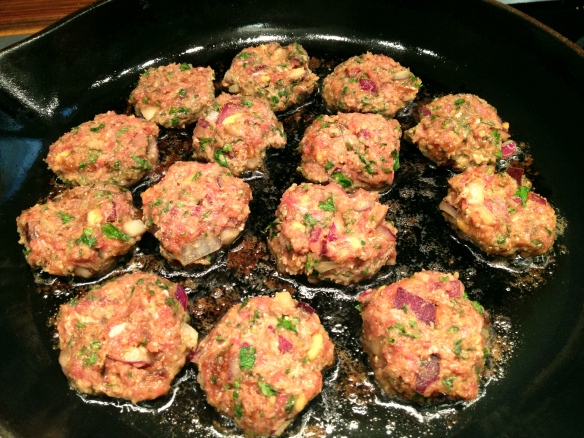I spent Thanksgiving with my family in South Florida. My 92-year-old grandparents finally relocated this past spring to be near my mom. It was a treat to spend the holiday with them after more than 25 years. While there were only six of us for Thanksgiving dinner, I ended up making a total of 11 dishes in order to satisfy various constituencies–including the aforementioned nonagenarians and a 16-year old vegan. And that doesn’t include dessert!
Here’s my 92-year-old grandma keeping guard over her wing while the bird rests. I was particularly gratified that she liked the butternut squash and creamed kale gratin, which was a divergence from her usual fare.
I got home to Brooklyn late last night. While I wasn’t thrilled to return to winter, I welcomed the opportunity to cater to my own tastes in my own kitchen. Best of all, I was able to cobble together the ingredients for this comforting dish without having to put on pants.
French Lentils
- Render 2 ounces of bacon in a medium-sized, heavy-bottomed pot over medium heat. (I highly recommend keeping some slab bacon in the freezer for such purposes.)
- Add some chopped onion. (I went with half of a large red onion that had been lingering in the fridge since before I left town.) Cook until onion is wilted and just starting to brown. (If your bacon is lean like mine and the bottom of the pan starts to get dark, add a half tablespoon of olive oil.)
- Add three small chopped carrots and saute until just beginning to soften. Then add four cups of water, a few cubes of frozen chicken stock (or some bouillon), and that last bit of red wine left over from your dinner party last weekend. Bring to a simmer and then add half a pound of French green lentils, a pinch of red pepper flakes and half a tablespoon of Herbes de Provence.
- Simmer until the lentils are soft and the broth has thickened a bit–roughly 45 minutes. Adjust seasoning with salt and pepper. Add three small carrots chopped into very small cubes and cook for a few more minutes. Stir in a tablespoon or so of red wine vinegar to provide a little balance.
This makes a great bed for just about any protein. I cooked the first half of these lentils for a dinner party a few months ago and served them with pan-roasted Scottish salmon to great effect. Tonight I went with a fried egg. The rich, oozy yolk was a perfect marriage with the earthy lentils.














